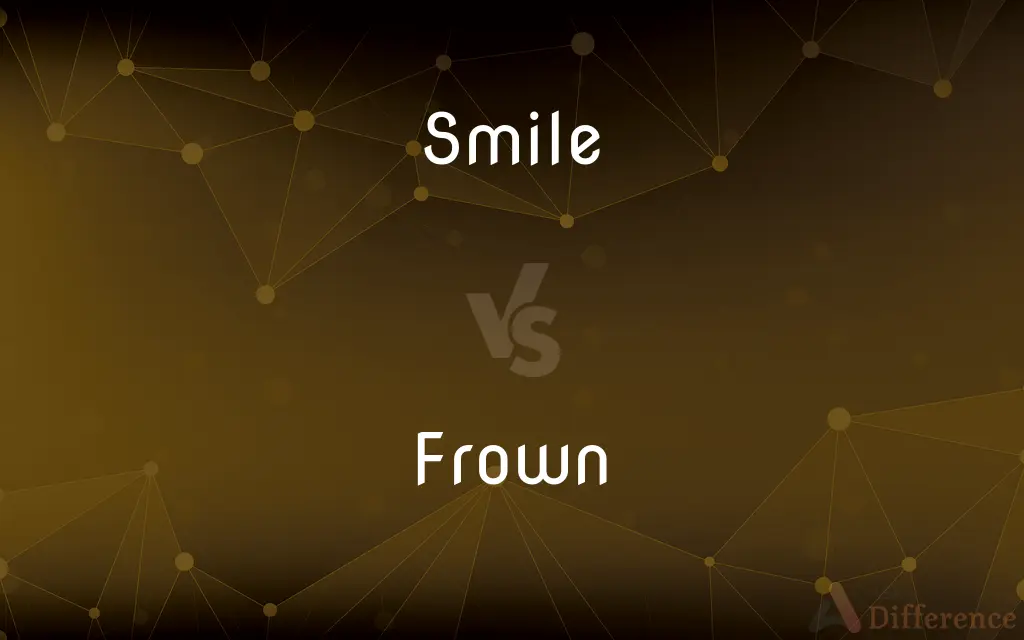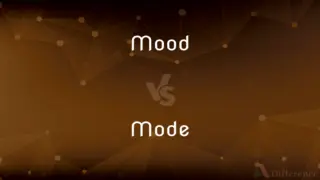Smile vs. Frown — What's the Difference?
By Tayyaba Rehman & Fiza Rafique — Updated on March 20, 2024
A smile is a facial expression formed by uplifting the corners of the mouth, often signifying happiness or pleasure, while a frown is marked by a furrowing of the brow, usually expressing sadness, disapproval, or concern.

Difference Between Smile and Frown
Table of Contents
ADVERTISEMENT
Key Differences
A smile is universally recognized as a sign of joy, friendliness, or amusement. It involves the upward movement of the corners of the mouth and can include the activation of muscles around the eyes, indicative of genuine happiness (Duchenne smile). This expression is often contagious and perceived as inviting, fostering social bonds and positive interactions. On the other hand, a frown involves the downward turn of the mouth and the furrowing of the eyebrows, reflecting negative emotions such as sadness, worry, or displeasure. Unlike smiling, frowning is frequently interpreted as a non-verbal cue for disagreement or concern, which can create a barrier to social interaction or serve as a signal that something is amiss.
The physiological impact of smiling and frowning also highlights their differences. Smiling has been linked to the release of neurotransmitters such as dopamine and serotonin, contributing to feelings of happiness and stress reduction. It can also influence others' perceptions, making the smiler appear more approachable, attractive, and trustworthy. Conversely, frowning is associated with an increase in stress hormones, which can enhance feelings of anxiety and negatively affect one's mood and health. However, in some contexts, frowning can be a powerful tool for communicating seriousness or disapproval without verbal exchange.
Smiles and frowns carry varying significances across different societies. While smiles are generally considered expressions of warmth and welcome worldwide, the context in which they are used can alter their interpretation. In some cultures, smiling at strangers is seen as polite and friendly, whereas, in others, it may be perceived as inappropriate or a sign of insincerity. Similarly, frowning, while typically associated with negative emotions, can also be interpreted as a sign of deep concentration or determination in certain cultural or situational contexts.
In literature and art, smiles and frowns are potent symbols representing the dichotomy of human emotions. Authors and artists often use these expressions to convey complex character emotions and underlying themes, from the joyous celebrations captured in Renaissance paintings to the profound sorrow depicted in classical literature. The impact of these expressions extends beyond their immediate visual or textual presentation, invoking empathy, reflection, or a deeper understanding of the human condition.
The ability to interpret and respond to smiles and frowns is crucial in social communication, highlighting the emotional state of the individual and influencing interpersonal dynamics. While a smile can draw people closer, fostering an environment of trust and cooperation, a frown can signal discomfort or disagreement, prompting an effort to address underlying issues or misunderstandings. This dynamic underscores the importance of non-verbal cues in human interaction and the complex interplay of facial expressions in conveying emotions and facilitating social connections.
ADVERTISEMENT
Comparison Chart
Facial Movement
Uplifting of mouth corners; may involve eyes
Downward turn of mouth; furrowing of eyebrows
Common Interpretation
Happiness, friendliness, amusement
Sadness, worry, displeasure
Physiological Impact
Releases happiness neurotransmitters, reduces stress
Can increase stress hormones
Cultural Significance
Generally positive, can vary by context
Generally negative, but can signify concentration or determination
Role in Communication
Invites social interaction, enhances perception of approachability
Indicates disapproval or concern, can deter social interaction
Compare with Definitions
Smile
An expression of joy or satisfaction.
He couldn't hide his smile when he saw the surprise.
Frown
An indicator of disagreement or disapproval.
The audience's frowns made the speaker nervous.
Smile
Can be contagious and improve mood.
His laughter and smile were so contagious that soon everyone was joining in.
Frown
Used in art and literature to convey negative emotions.
The statue's frown captured the tragedy of the scene.
Smile
A polite or forced expression of happiness.
She offered a polite smile to her distant relatives.
Frown
Can signal to others to approach with caution or empathy.
Seeing her frown, her friend asked what was wrong to offer support.
Smile
A symbol of positive emotions in art and literature.
The character's smile in the painting symbolized the joy of spring.
Frown
A facial expression showing displeasure or concentration by furrowing the brow.
She frowned at the puzzling question, deep in thought.
Smile
A facial expression featuring the upward curve of the mouth's corners.
Her smile lit up the room, making everyone feel welcome.
Frown
A sign of worry or sadness.
His frown deepened as he heard the bad news.
Smile
A smile is formed primarily by flexing the muscles at the sides of the mouth. Some smiles include a contraction of the muscles at the corner of the eyes, an action known as a Duchenne smile.
Frown
A frown (also known as a scowl) is a facial expression in which the eyebrows are brought together, and the forehead is wrinkled, usually indicating displeasure, sadness or worry, or less often confusion or concentration. The appearance of a frown varies by culture.
Smile
A facial expression characterized by an upward curving of the corners of the mouth and indicating pleasure, amusement, or derision.
Frown
To make a facial expression indicating thought or displeasure, as by wrinkling the brow and drawing down the corners of the mouth.
Smile
To have or form a smile.
Frown
To regard something with disapproval or distaste
Frowned on the use of so much salt in the food.
Smile
To look with favor or approval
Fortune smiled on our efforts.
Frown
A facial expression indicating thought or displeasure; a scowl.
Smile
To express cheerful acceptance or equanimity
We smiled at the bad weather and kept going.
Frown
A wrinkling of the forehead with the eyebrows brought together, typically indicating displeasure, severity, or concentration.
Smile
To express with a smile
Grandmother smiled her consent.
Frown
(intransitive) To have a frown on one's face.
She frowned when I told her the news.
Smile
A facial expression comprised by flexing the muscles of both ends of one's mouth, often showing the front teeth, without vocalisation, and in humans is a common involuntary or voluntary expression of happiness, pleasure, amusement, goodwill, or anxiety.
She's got a perfect smile.
He has a sinister smile.
She had a smile on her face.
He always puts a smile on my face.
Frown
To manifest displeasure or disapprobation; to look with disfavour or threateningly.
Noisy gossip in the library is frowned upon.
Smile
(figurative) Favour; propitious regard.
The smile of the gods
Frown
(transitive) To repress or repel by expressing displeasure or disapproval; to rebuke with a look.
Let us frown the impudent fellow into silence.
Smile
A drink bought by one person for another.
Frown
(transitive) To communicate by frowning.
Frank frowned his displeasure with my proposal.
Smile
(ambitransitive) To have (a smile) on one's face.
When you smile, the whole world smiles with you.
I don't know what he's smiling about.
She smiles a beautiful smile.
Frown
To contract the brow in displeasure, severity, or sternness; to scowl; to put on a stern, grim, or surly look.
The frowning wrinkle of her brow.
Smile
(transitive) To express by smiling.
To smile consent, or a welcome
Frown
To manifest displeasure or disapprobation; to look with disfavor or threateningly; to lower; as, polite society frowns upon rudeness.
The sky doth frown and lower upon our army.
Smile
(intransitive) To express amusement, pleasure, or love and kindness.
Frown
To repress or repel by expressing displeasure or disapproval; to rebuke with a look; as, frown the impudent fellow into silence.
Smile
(intransitive) To look cheerful and joyous; to have an appearance suited to excite joy.
The sun smiled down from a clear summer sky.
Frown
A wrinkling of the face in displeasure, rebuke, etc.; a sour, severe, or stern look; a scowl.
His front yet threatens, and his frowns command.
Her very frowns are fairer farThan smiles of other maidens are.
Smile
(intransitive) To be propitious or favourable; to countenance.
The gods smiled on his labours.
Frown
Any expression of displeasure; as, the frowns of Providence; the frowns of Fortune.
Smile
To express amusement, pleasure, moderate joy, or love and kindness, by the features of the face; to laugh silently.
He doth nothing but frown. . . . He hears merry tales and smiles not.
She smiled to see the doughty hero slain.
When last I saw thy young blue eyes, they smiled.
Frown
A facial expression of dislike or displeasure
Smile
To express slight contempt by a look implying sarcasm or pity; to sneer.
'T was what I said to Craggs and Child,Who praised my modesty, and smiled.
Frown
Look angry or sullen, wrinkle one's forehead, as if to signal disapproval
Smile
To look gay and joyous; to have an appearance suited to excite joy; as, smiling spring; smiling plenty.
The desert smiled,And paradise was opened in the wild.
Smile
To be propitious or favorable; to favor; to countenance; - often with on; as, to smile on one's labors.
Smile
To express by a smile; as, to smile consent; to smile a welcome to visitors.
Smile
The act of smiling; a peculiar change or brightening of the face, which expresses pleasure, moderate joy, mirth, approbation, or kindness; - opposed to frown.
Sweet intercourseOf looks and smiles: for smiles from reason flow.
Smile
A somewhat similar expression of countenance, indicative of satisfaction combined with malevolent feelings, as contempt, scorn, etc; as, a scornful smile.
Smile
Favor; countenance; propitiousness; as, the smiles of Providence.
Smile
Gay or joyous appearance; as, the smiles of spring.
The brightness of their [the flowers'] smile was gone.
Smile
A facial expression characterized by turning up the corners of the mouth; usually shows pleasure or amusement
Smile
Change one's facial expression by spreading the lips, often to signal pleasure
Smile
Express with a smile;
She smiled her thanks
Common Curiosities
Can smiling really improve your mood?
Yes, smiling can trigger the release of neurotransmitters that contribute to a better mood.
Do people smile the same way in all cultures?
While smiling is a universal expression, cultural norms influence when and how people smile.
Is frowning always a sign of unhappiness?
Not always; frowning can also indicate concentration, concern, or determination.
Can other people's facial expressions affect our emotions?
Yes, facial expressions like smiles and frowns can be contagious, influencing the emotions of others.
How important are smiles and frowns in communication?
Very important; they provide non-verbal cues that help convey emotions and intentions, influencing social interactions.
Do smiles and frowns have the same impact online as in person?
While their impact can be significant online, especially with emojis, the physical presence and subtleties of in-person expressions have a unique effect.
How do artists use smiles and frowns in their work?
Artists use these expressions to convey a wide range of emotions, character traits, and underlying themes, enhancing the narrative or visual impact of their work.
Why is it important to understand the cultural context of smiling and frowning?
Understanding cultural contexts can prevent miscommunications and help interpret expressions accurately in social interactions.
Is it possible to misinterpret a smile or frown?
Yes, depending on cultural norms and the context of the interaction, smiles and frowns can be misinterpreted.
Can forcing a smile make you feel happier?
Studies suggest that even forced smiles can lead to a slight increase in mood due to the facial feedback hypothesis.
Share Your Discovery

Previous Comparison
Mood vs. Mode
Next Comparison
Periosteum vs. EndosteumAuthor Spotlight
Written by
Tayyaba RehmanTayyaba Rehman is a distinguished writer, currently serving as a primary contributor to askdifference.com. As a researcher in semantics and etymology, Tayyaba's passion for the complexity of languages and their distinctions has found a perfect home on the platform. Tayyaba delves into the intricacies of language, distinguishing between commonly confused words and phrases, thereby providing clarity for readers worldwide.
Co-written by
Fiza RafiqueFiza Rafique is a skilled content writer at AskDifference.com, where she meticulously refines and enhances written pieces. Drawing from her vast editorial expertise, Fiza ensures clarity, accuracy, and precision in every article. Passionate about language, she continually seeks to elevate the quality of content for readers worldwide.














































